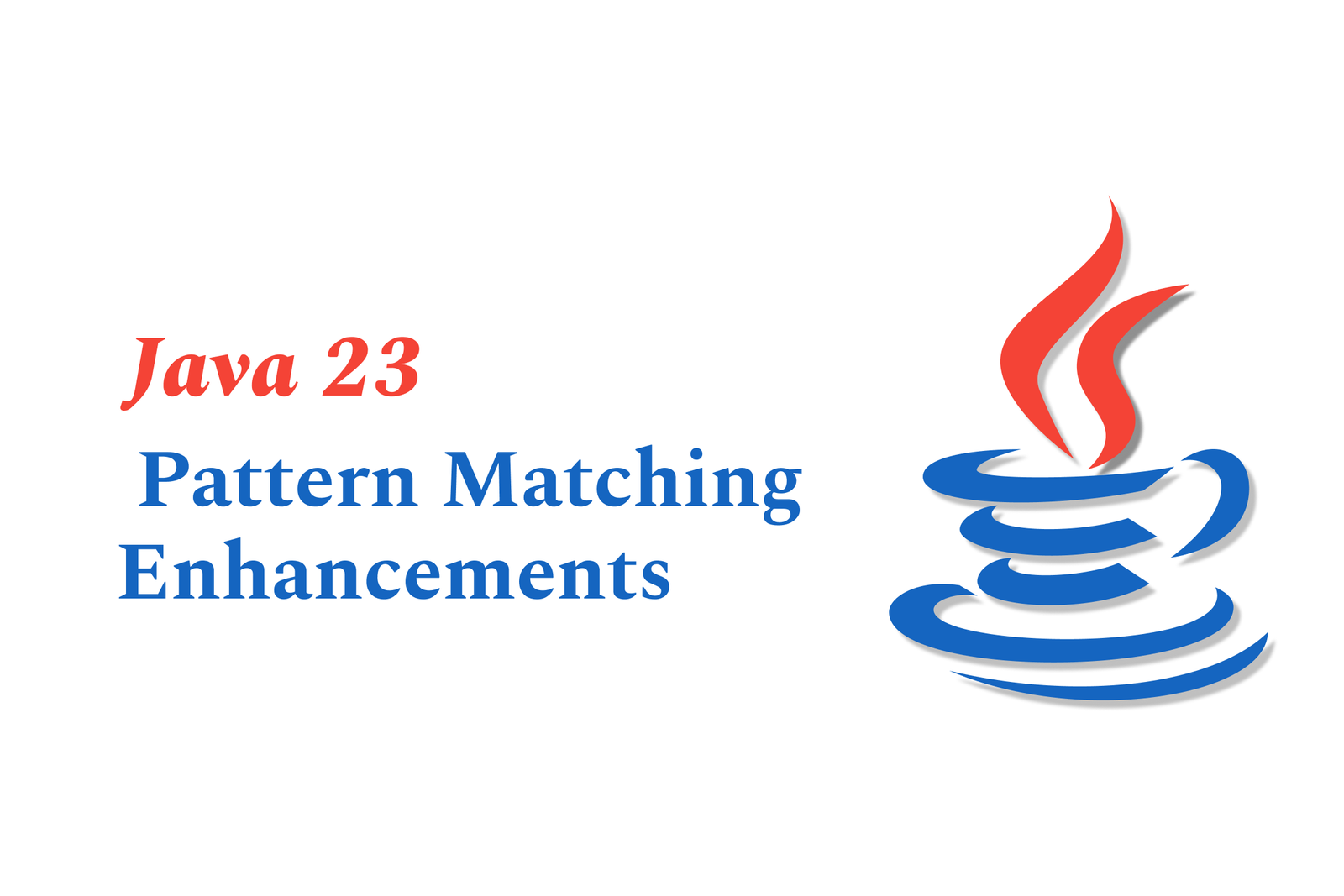Java 23 pattern matching enhancements
Java 23 enhances pattern matching by extending support in `instanceof` and switch statements, improving type safety, allowing primitive and record patterns, and simplifying null handling. These upgrades enable more concise, readable, and expressive code for type-based logic.
Java 23 Pattern Matching Enhancements
1 ) Introduction to Pattern Matching in Java
Pattern matching tests if an object fits a specific structure and extracts data if matched.
Java previously supported this via `instanceof`, with enhancements to make code more concise and robust.
Patterns serve as conditions in expressions/statements to test target objects.
Example: `s instanceof Rectangle r` tests if `s` is a Rectangle and assigns it to `r`.
2 ) Pattern Matching with `instanceof` and Switch
`instanceof` with pattern matching declares pattern variables initialized on successful match.
Patterns appear in switch case labels, enabling clean handling of multiple types.
Example switch with pattern matching:
java
switch (s) {
case Rectangle r > return r.length() * r.width();
case Circle c > return c.radius() c.radius() Math.PI;
default > throw new IllegalArgumentException("Unrecognized shape");
}
This removes boilerplate casting and improves readability.
3 ) Type Patterns and Record Patterns
Type pattern: a type plus a pattern variable (e.g., `Rectangle r`).
Record pattern: matches record types by extracting components directly.
Example: matching a record `Point`:
java
record Point(double x, double y) {}
if (obj instanceof Point(double a, double b)) {
// a and b initialized directly
}
This simplifies deconstruction and variable extraction from records.
4 ) Advancements in Java 23’s Pattern Matching
Enhanced pattern matching for switch statements allows type safe, concise handling of multiple types without verbose if else chains.
Support for primitive types in pattern matching within `instanceof` and switch statements increases expressiveness and reduces boilerplate.
Enhanced null handling in switch pattern matching adds robustness.
Record and sealed types are fully supported in pattern matching contexts.
5 ) Benefits for Developers
More readable, concise, and maintainable code when handling type specific logic.
Reduction of explicit casts and manual extractions.
Improved potential for behind the scenes optimizations due to well defined pattern structures.
Seamless integration in modern Java programming, especially in complex control flow.
6 ) Practical Use Cases
Dynamically processing inputs based on runtime type in microservices.
Simplifying complex conditional logic in data deserialization and validation.
Leveraging clean syntax to destructure immutable records easily.
7 ) Conclusion
Java 23 expands and refines pattern matching features, making it a powerful tool for developers to write clearer, safer, and more efficient code. The enhancements in pattern matching within `instanceof` and switch statements, along with support for record patterns, mark a significant step towards expressive and robust Java programming.
https://justacademy.in/news-detail/android-new-api-releases
https://justacademy.in/news-detail/how-react-native-is-evolving-with-the-latest-tech
https://justacademy.in/news-detail/flutter-forward-2025-recap
https://justacademy.in/news-detail/android-file-management-app-innovations
https://justacademy.in/news-detail/react-native?s-role-in-ai-powered-mobile-experiences
Related Posts
In 2025, top Angular libraries offer modern, feature-rich components and tools for building dynamic web apps. From powerful data grids to low-code platforms like UI Bakery, these libraries enhance development speed, UI design, and scalability, making them essential for Angular developers.
Migrating from AngularJS to Angular 17 involves gradually upgrading your app by running both frameworks together using tools like ngUpgrade, rewriting components in TypeScript, and adopting Angular’s modern architecture to enhance performance, maintainability, and long-term support.
Angular state management tools help organize and handle app data efficiently, improving scalability and maintainability. Popular options include NgRx for robust, RxJS-based patterns, and newer Signal Store solutions that offer simpler, reactive approaches integrated tightly with Angular’s latest features.
RxJS in Angular empowers developers to manage asynchronous data streams with powerful operators like `forkJoin`, `combineLatest`, and `zip`. Mastering these key operators in 2025 is essential for building efficient, reactive applications that handle complex event sequences seamlessly.
Angular performance optimization in 2025 focuses on improving app speed and responsiveness by using techniques like OnPush change detection, lazy loading, efficient data caching, and AOT compilation. These practices reduce load times, enhance user experience, and ensure scalable, fast Angular applications.
In 2025, Angular remains preferred for large-scale, enterprise apps with its robust, all-in-one framework, while Vue attracts developers seeking simplicity and fast development for smaller projects. Both frameworks excel, with choice driven by project needs and team expertise.
Angular Signals are a new reactive primitive in Angular 16 that enable fine-grained, efficient change detection by automatically tracking dependencies and updating only affected parts of the UI. They simplify state management and boost app performance, revolutionizing Angular's reactivity model.
Angular interview questions to prepare in 2025 focus on core concepts like components, directives, data binding, routing, and dependency injection, along with TypeScript mastery and latest Angular features to ensure strong practical knowledge for building scalable, efficient web applications.
AngularJS reached its official end of support in January 2022, meaning no further updates or security patches. To ensure app security and performance, developers should consider migrating to modern Angular versions or seek third-party long-term support options if immediate migration isn’t possible.
The Angular Roadmap 2025 highlights upcoming features focused on improving developer experience and performance, including zoneless Angular, Signals integration, enhanced Forms, async data handling, improved HMR, and expanded Angular Material/CDK enhancements, driving modern, efficient web app development.










